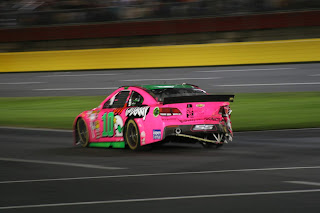Rookie Stripe: NASCAR Through History -- A Rookie’s Timeline
 |
| Photo credit: Logan Stewart Kureczka for Skirts and Scuffs |
Talk about a sport destined to become a ball of fire.
Some say that NASCAR grew out of bootlegging and moonshining during prohibition in Appalachia, where making and selling homemade whiskey financially aided families mired in poverty. And, you might not also know that stock car’s very first racing events were held on Daytona Beach – literally, on the beach.
Please – leave the swimsuits and floaties at home.
To really get an encyclopedic sense of the history of NASCAR, or at least help you seem that discerning, read on for an easy-to-digest timeline of what big events happened when.
1947: Service station owner Bill France Sr. hosts a meeting in Daytona Beach to discuss the future of stock car racing; the National Association for Stock Car Auto Racing (NASCAR) is officially created.
1948: NASCAR is incorporated and the first NASCAR-sanctioned race takes place on Daytona Beach on February 15. The winner is Red Byron. NASCAR is incorporated shortly thereafter.
1949: The “Strickly Stock” race is held at the Charlotte Fairgrounds on June 19 in Charlotte, N.C., drawing a massive crowd and setting the new racing series up for future success. (Fun fact: Though Jim Roper wins the race, Sara Christian finishes 14th and is widely credited as the first female to race in NASCAR’s top series.)
1950: Retired racer Brasington purchases 70 acres of cotton and peanut farmland from farmer Sherman Ramsey in Darlington, S.C., and builds a race track. He has to make it an egg-shaped oval with a tighter, narrower corner that is more steeply banked in order not to disturb Ramsey’s minnow pond at the west side of the property. The first Southern 500, a 500-mile NASCAR race, is held at that track during the summer. Darlington is notable because it is the first race on asphalt. NASCAR also gets its first sponsor in 1950, Nash Motor Company.
1958: Fireball Roberts is named Professional Athlete of the Year, the first race car driver to get the honor.
1959: With NASCAR racing exploding in popularity, former racing events at the beach are moved to the 2.5-mile tri-oval Daytona International Speedway, featuring high-banked turns and a long back straightaway.
1960: Atlanta and Charlotte open new superspeedways.
1961: The Firecracker 250 at Daytona Beach is televised on ABC’s the Wide World of Sports.
1963: Wendell Scott wins at Jacksonville Speedway in Florida, the first African-American to win a race in the top series of NASCAR.
1969: Bill France, Sr. opens the Alabama International Motor Speedway, today called Talladega Superspeedway. At the time, the 2.66-mile track was the fastest and biggest track on the planet.
1970: Buddy Baker becomes the first driver to surpass 200 miles per hour in his race car.
1971: R.J. Reynolds Tobacco signs on as a corporate sponsor, meaning NASCAR’s top series will become the NASCAR Winston Cup Series
1972: Bill France, Sr. passes leadership of NASCAR to his son Bill, Jr. on January 10.
1977: Janet Guthrie runs the Daytona 500, the first woman to do so, finishing 12th.
1979: Richard Petty wins his seventh series championship on November 18, a new record in NASCAR.
1987: The new fastest speed record is set by Bill Elliott; 212.809 miles per hour at Talladega.
1992: Richard Petty retires on November 15.
1999: NASCAR signs notable partnerships with Fox, NBC and Turner sports. NASCAR celebrates its 50th anniversary on May 18.
2001: Dale Earnhardt Sr. is killed in a crash in the final lap of the 2001 Daytona 500, shocking fans worldwide.
2002: Tony Stewart wins the championship and newer, younger drivers suddenly start to grow in popularity with fans. Fresh faces that come to represent NASCAR include Dale Earnhardt Jr., Jimmie Johnson, Kevin Harvick, Ryan Newman, Kurt Busch and Matt Kenseth.
2003: NASCAR opens the NASCAR Research and Development Center in Concord, N.C. Brian France also takes over as NASCAR Chairman and CEO.
2004: NASCAR begins its first season with naming rights partner Nextel, which will later become Sprint. The Chase is also launched as the post-season championship for NASCAR, and Kurt Busch wins the first Chase.
2009: The new NASCAR Hall of Fame (Charlotte, N.C.) has an inaugural class that includes Bill France Sr., Bill France Jr., Richard Petty, Dale Earnhardt and Junior Johnson.
2017: A new three-stage format of racing is launched by NASCAR in all three of its series of racing. across all three national series racing. Monster Energy also takes over as naming rights partner on January 1.
2018: Jim France takes over as NASCAR Chairman and CEO from his brother Bill France, Jr.
 |
| Photo credit: Logan Stewart Kureczka for Skirts and Scuffs |
Rookie Stripe: NASCAR Through History -- A Rookie’s Timeline
 Reviewed by Logan Stewart
on
Thursday, August 29, 2019
Rating:
Reviewed by Logan Stewart
on
Thursday, August 29, 2019
Rating:
 Reviewed by Logan Stewart
on
Thursday, August 29, 2019
Rating:
Reviewed by Logan Stewart
on
Thursday, August 29, 2019
Rating:






